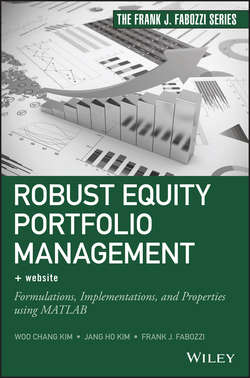Robust Equity Portfolio Management

Реклама. ООО «ЛитРес», ИНН: 7719571260.
Оглавление
Fabozzi Frank J.. Robust Equity Portfolio Management
The Frank J. Fabozzi Series
Preface
Chapter 1. Introduction
1.1 Overview of the Chapters
1.2 Use of MATLAB
Chapter 2. Mean-Variance Portfolio Selection
2.1 Return of Portfolios
2.2 Risk of Portfolios
2.3 Diversification
2.4 Mean-Variance Analysis
2.5 Factor Models
2.6 Example
Key Points
Chapter 3. Shortcomings of Mean-Variance Analysis
3.1 Limitations on the Use of Variance
3.2 Difficulty in Estimating the Inputs
3.3 Sensitivity of Mean-Variance Portfolios
3.4 Improvements on Mean-Variance Analysis
Key Points
Chapter 4. Robust Approaches for Portfolio Selection
4.1 Robustness
4.2 Robust statistics
4.3 Shrinkage Estimation
4.4 Monte Carlo Simulation
4.5 Constraining Portfolio Weights
4.6 Bayesian Approach
4.7 Stochastic Programming
4.8 Additional Approaches
Key Points
Chapter 5. Robust Optimization
5.1 Worst-Case Decision Making
5.2 Convex Optimization
5.3 Robust Counterparts
5.4 Interior Point Methods
Key Points
Chapter 6. Robust Portfolio Construction
6.1 Some Preliminaries
6.2 Mean-Variance Portfolios
6.3 Constructing Robust Portfolios
6.4 Robust Portfolios with Box Uncertainty
6.5 Robust Portfolios with Ellipsoidal Uncertainty
6.6 Closing Remarks
Key Points
Chapter 7. Controlling Third and Fourth Moments of Portfolio Returns via Robust Mean-Variance Approach
7.1 Controlling Higher Moments of Portfolio Return
7.2 Why Robust Formulation Controls Higher Moments
7.3 Empirical Tests
Key Points
Chapter 8. Higher Factor Exposures of Robust Equity Portfolios
8.1 Importance of Portfolio Factor Exposure
8.2 Fundamental Factor Models in the Equity Market
8.3 Factor Dependency of Robust Portfolios: Theoretical Arguments
8.4 Factor Dependency of Robust Portfolios: Empirical Findings
8.5 Factor Movements and Robust Portfolios
8.6 Robust Formulations That Control Factor Exposure
Key Points
Chapter 9. Composition of Robust Portfolios
9.1 Overview of Analyses
9.2 Composition Based on Investment Styles
9.3 Composition Based on Additional Factors
9.4 Composition Based on Stock Betas
9.5 Robust Portfolio Construction Based on Stock Beta Attributes
Key Points
Chapter 10. Robust Portfolio Performance
10.1 Portfolio Performance Measures
10.2 Historical Performance of Robust Portfolios
10.3 Measuring Robustness
Key Points
Chapter 11. Robust Optimization Software
11.1 YALMIP
11.2 ROME (Robust Optimization Made Easy)
11.3 AIMMS
Key Points
About the Authors
About the Companion Website
Отрывок из книги
Robust Equity
Management +
.....
Chapter 2 begins by describing how portfolio return and risk are measured, which leads to formulating the mean-variance portfolio problem. Mean-variance analysis finds the optimal portfolio from the trade-off between return and risk, and the framework also explains the benefits of diversification. Chapter 3 investigates shortcomings of the mean-variance model, which limit its use as a strategy for managing equity portfolios; improvements can be made with respect to measuring risk, estimating the input variables, and reducing the sensitivity of portfolio weights. In particular, the combination of estimation errors in the input values and high sensitivity of the resulting portfolio is a major issue with the mean-variance model. Therefore, in Chapter 4, practices for reducing the sensitivity of portfolios are demonstrated, including robust statistics, simulation methods, and stochastic programming.
Chapter 5 presents a comprehensive overview of optimization, including definitions of linear programming, quadratic programming, and conic optimization. The chapter also discusses how robust optimization transforms basic optimization problems so as to incorporate parameter uncertainty. The discussion is extended to applying robust optimization to portfolio selection in Chapter 6. While concentrating on the uncertainty caused by estimating expected returns of stocks, two robust formulations are shown with specific instructions provided as to their implementation.
.....